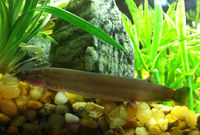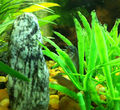Java Loach (Pangio oblonga)
From The Aquarium Wiki
Java Loach
Pangio oblonga
76 Litres (20 US G.)
7-8 cm (2.8-3.1")
Freshwater
6.5 - 7.5
23 -25 °C (73.4-77°F)
6-10 °d
1:2 M:F
3-5 years
Family
Cobitidae
Contents
Additional names
- Java Loach, Black Khuli Loach, Chocolate Kuhli, Cinnamon Loach
Additional scientific names
- Pangio javanicus, Acanthophthalmus javanicus, Acanthopthalmus oblongus, Cobitis oblonga, Pangio oblongus
Origin[edit]
- Found in streams with muddy bottoms among shore vegetation and leaf litter throughout Vietnam, Laos, Cambodia, Thailand, Malaysia and Indonesia. Also reported in India and Myanmar.
Sexing[edit]
- Very little sexual dimorphism present except at breeding time when females will be noticeably more plump around the belly with eggs.
Tank compatibility[edit]
- This fish must be kept with at least 4-5 of its own kind, the bigger the group the more active they will be. Will co-habit with other peaceful fish, do not keep with very aggressive fish.
Diet[edit]
- Will accept high quality sinking pellets. Bloodworms and brine shrimp make good treats.
Feeding regime[edit]
- Can be fed up to three times daily.
Environment specifics[edit]
- Java Loaches should not be considered for a new aquarium; they need a well-established, planted aquarium. The substrate should not be coarse as this will harm their barbels, a soft sand substrate is ideal. Many hiding places should be provided, make sure all hiding places and décor is secure so it is not dislodged by this fish's activity on the substrate.
Behaviour[edit]
- A peaceful bottom-dweller that tends to be shy when not kept in groups. This fish can often be seen swimming in circles along the sides of the tank. This behavior is known as "dancing" and is normal for the species. Dancing is most frequently observed during water changes and feeding, however this fish may dance without provocation.
- Java Loaches enjoy weaving their eel-like bodies in and around plant stems and roots. This behavior is normal, but can dislodge plants from their desired location. Therefore, it is best to use soft round pebbles or stones to secure new plants until they are properly rooted when placed in an aquarium with the Java Loach.
Identification[edit]
- The fish is uniform in colour ranging from a reddish-brown or milk chocolate colour to almost black. The fins are translucent and the belly is usually paler than the rest of the body.
Pictures[edit]
External links[edit]
- Fishbase (Mirrors: Error creating thumbnail: Unable to save thumbnail to destination)


